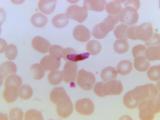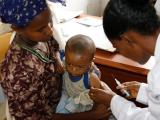Dec 6, 2011 (CIDRAP News) Though global rates of the most deadly form of malaria are declining in Africa, the parasite's less deadly but more difficult-to-treat cousin, Plasmodium vivax, has a firm foothold in many parts of South Asia and Latin America, according to new mapping studies.
The maps, produced by researchers from the Malaria Atlas Project (MAP) at the University of Oxford, were released yesterday in Philadelphia at the annual meeting of the American Society of Tropical Medicine and Hygiene (ASTMH).
Malaria from P vivax is more common throughout the world than the more lethal P falciparum, which is predominant in Africa. Experts estimate that 2.85 billion people across the globe are at risk for P vivax, which can hide out in the liver for months or years, making it difficult to detect and treat. P vivax also tolerates cooler temperatures than does P falciparum.
Dr Peter Gething, who led the team's vivax malaria burden study, said in an ASTMH press release that the maps help show how difficult it will be to eradicate malaria. "It shows that in substantial part of the world, P vivax malaria is endemic and transmission is significant. Unfortunately, the tools for fighting this type of malaria range from ineffective to nonexistent," he said.
Some of the hot spots for P vivax malaria include large portions of India, even in urban areas such as Mumbai. High rates of infection are also occurring in Papua New Guinea, Indonesia, and Myanmar, including Yangon.
In the Americas, active areas include a large portion of the northern Amazon region, mostly in Brazil, plus parts of Peru, Colombia, and Venezuela. Central America's vivax malaria hot spots include nearly all of Nicaragua and regions of Honduras and Guatemala.
Gething said in the press release that, P vivax malaria infection rates are low for most of Africa, though moderate but stable levels are seen in part of the Horn of Africa and in Madagascar.
Last year the group issued a map showing where P vivax malaria occurs, but experts asked for one showing where the infections are most prevalent as a tool to help form a strategy to fight the disease, the press release said.
Areas were considered hot spots if infection rates topped 7%, a level considered low for P falciparum, but high for P vivax, because the number represents only infections that are detectable in blood and because disease rates are difficult to reduce, Gething said in the statement.
Two studies conducted in Indonesia to be presented at the meeting suggest that P vivax infections are more often severe or fatal than previously thought. One, conducted by researchers at the Eijkman-Oxford Clinical Research Unit in Jakarta, found that malaria patients at a hospital in the eastern part of the country linked P vivax to severe illnesses and deaths and found that the risk of death was the same regardless of the type of malaria parasite.
Dr J. Kevin Baird, one of the researchers involved in the study, said in the press release that there are little data on how deadly P vivax infections are, "but what data we do have worries me a great deal."
P vivaxendemic areas have a large reservoir of the disease in people who carry the parasites in their liver, a situation that is difficult to measure, because there is no test to detect liver parasites. "One person with vivax actually can represent multiple malaria infections over many years in a single community, and each time the parasite moves from the liver to the blood, it contributes anew to disease burden and transmission," he added.
Only one drug, primaquine, can clear the parasites from the liver, but some people in endemic areas have a hereditary conditionG6PD deficiency that produces a toxic and sometimes fatal reaction to the drug. At another ASTMH meeting session this week, another group from the MAP project will release a map showing the prevalence of the condition.
Dr Rosalind Howes, one of the group's investigators, said in the statement that the G6PD deficiency map could help experts gauge the risks and benefits of using primaquine.
Two methods that have been used to prevent P falciparum infection, bed nets and indoor spraying, aren't effective for battling P vivax, because the mosquitoes that carry them typically bite outdoors, the ASTMH said. A malaria vaccine that is in phase 3 trials and is close to being commercially available also does not target P vivax, it said.
The ASTMH said researchers at this week's meeting will present preclinical studies on improved drugs to treat P vivax malaria and early findings from a trial of a vivax vaccine candidate.
Issues surrounding P vivax have raised questions about what precautions travelers who visit affected areas should take, according to the ASTMH. A new report in the December issue of the American Journal of Tropical Medicine and Hygiene from experts at the US Centers for Disease Control and Prevention (CDC) and Walter Reed Army Institute of Research suggests that travelers to some parts of Latin America may still want to take anti-malaria drugs, even though overall malaria rates there are declining.
They noted that US residents heading to coastal or urban areas are less likely to encounter P vivax malaria, but they said an increasing number of travelers are interested in more remote locations, such as inland Latin American destinations, where the disease is more common.
They also noted that the form of the disease is common in many of Southeast Asia's urban areas, and that those heading to areas where P vivax transmission occurs should consider taking primaquine, unless they are pregnant or have G6PD deficiency.
Dr Peter Hotez, president of the ASTMH, said in the statement that it's time to step up the fight against P vivax malaria and to stop thinking of it as mild and tolerable. "We expect to emerge from this year's conference with a far better view of the state of vivax infections around the world and with new knowledge on treatment challenges that can guide a global strategy focused on eradicating all forms of malaria."
Steinhardt LC, Magill AJ, Arguin PM. Review: malaria chemoprophylaxis for travelers to Latin America. Am J Trop Med Hyg 2011 Dec;85(6):1015-24 [Abstract]
See also:
Dec 5 ASTMH press release
MAP Web site
Dec 6 G6PD deficiency map abstract



















